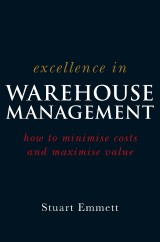Details

Excellence in Warehouse Management
How to Minimise Costs and Maximise Value1. Aufl.
|
37,99 € |
|
| Verlag: | Wiley |
| Format: | EPUB |
| Veröffentl.: | 10.03.2011 |
| ISBN/EAN: | 9781119995166 |
| Sprache: | englisch |
| Anzahl Seiten: | 320 |
DRM-geschütztes eBook, Sie benötigen z.B. Adobe Digital Editions und eine Adobe ID zum Lesen.
Beschreibungen
Warehouses are often seen as a necessary evil: places that stop the flow of goods and thus increase costs without adding value. But the truth is that they have a critical part to play in supply chain management, and warehouse managers should be centrally involved in the strategic aspects of any business. Excellence in Warehouse Management covers everything you need to know to manage warehouse operations as part of a streamlined and holistic system, fine-tuned to serve the customer and drive the bottom-line. With thinking points, self-assessment exercises and case studies Stuart Emmett challenges you to consider your own operations in a new way, and plot a course into the future.
<p>Introduction ix</p> <p>Abbreviations xi</p> <p>Acknowledgements xv</p> <p><b>1: The Role of Warehousing and Stores 1</b></p> <p>Warehousing and the supply chain 1</p> <p>Training topics 2</p> <p>Definitions 4</p> <p>Strategic aspects of warehousing 5</p> <p>Customers 7</p> <p>The value chain 9</p> <p>Warehouse location 12</p> <p>Modern warehouse operations 14</p> <p>World-class warehousing 21</p> <p>Conclusion 24</p> <p><b>2: Inventory, Stock Analysis and Classifying Products 25</b></p> <p>Product classification 25</p> <p>Demand analysis 26</p> <p>ABC analysis 30</p> <p>Product coding 34</p> <p>Product handling groups 34</p> <p>Inventory management: why hold stock? 35</p> <p>Inventory costs and service 37</p> <p>Lead time 41</p> <p>Demand forecasting 46</p> <p>Inventory and statistics 48</p> <p>How much stock should be held? 51</p> <p>Replenishment methods 54</p> <p>Questions about inventory 65</p> <p>Appendix 72</p> <p><b>3: Stock Control 75</b></p> <p>Stock inaccuracy 75</p> <p>Continuous or periodic stock checking 77</p> <p>COPYRIGHTED MATERIAL</p> <p>Stock control 79</p> <p>Security and preventing loss 81</p> <p>Information security 84</p> <p>Training topics 86</p> <p><b>4: The Warehouse and Operational Principles 88</b></p> <p>Warehouse structure 88</p> <p>Warehouse operations 90</p> <p>Receiving 91</p> <p>Location methods in the warehouse 96</p> <p>Picking options 97</p> <p>Customer orders 99</p> <p>Methods of picking 100</p> <p>Despatching activity 110</p> <p>Organising for flow 111</p> <p><b>5: Equipment 112</b></p> <p>Fork-lift trucks 112</p> <p>Racking/shelving 119</p> <p>The aisle width decision 125</p> <p><b>6: Warehouse Information Communications Technology 128</b></p> <p>Importance of information 128</p> <p>Decision-making and ICT 132</p> <p>Improvements with ICT 133</p> <p>Warehouse ICT applications 134</p> <p>Systems implementation 149</p> <p><b>7: Regulations 153</b></p> <p>Health and safety at work 153</p> <p>Management of health and safety 154</p> <p>Health and safety arrangements 158</p> <p>Warehouse health and safety risks 160</p> <p>Risk assessments 164</p> <p>Fork-lift trucks: health and safety 166</p> <p><b>8: Productivity, Cost and Service 173</b></p> <p>Framework for analysis 173</p> <p>Key costs 174</p> <p>Key productivity drivers 176</p> <p>Basic improvements 179</p> <p>Understanding productivity 189</p> <p>Determining pricing and charging 192</p> <p>Customer service 195</p> <p>Added value 203</p> <p>Warehouse layout 208</p> <p>Training topics 210</p> <p><b>9: Outsourcing 212</b></p> <p>Users’ views of third parties and the marketplace 212</p> <p>Selecting third parties 220</p> <p>Training topics 225</p> <p><b>10: People Management 227</b></p> <p>Company culture 227</p> <p>Management 231</p> <p>Work objectives and performance 235</p> <p>Motivating people 245</p> <p>Empowering 251</p> <p>Teams 252</p> <p>Communication 254</p> <p>Managing change 255</p> <p>Warehouse picking operatives 262</p> <p>Training topics 264</p> <p><b>11: Developments and Trends 268</b></p> <p>Supply chain impacts on stores and warehousing 268</p> <p>Global logistics 270</p> <p>Reverse logistics and customer returns 271</p> <p>Risk 277</p> <p>Roads 278</p> <p>Legislation 279</p> <p>Technology 279</p> <p>People development 279</p> <p>Political influences 280</p> <p>The supply chain 282</p> <p>Warehouse aims/ideals 286</p> <p>Useful Information and Websites 288</p> <p>Bibliography 290</p> <p>Index 292</p>
"...this book is easy to read...worth the investment..." (Supply Management, 3rd November 2005) <p>" In Stuart Emmett, we have not only one of the countries acknowledged leaders in training, but who also has the practical background to relate this to the real problems faced by managers ". --John Perry, Managing Director Scala Consulting Ltd.</p> <p>" Thank you for your support and help over the last 12 months". --Dorothea de Carvalho, Director of Professional Development, Institute of Logistics and Transport.</p>
Stuart Emmett is a trainer, consultant and mentor, operating through learnexchange.com, his background is in managing warehouses. <p>He has written 3 books, various learning and technical material and a wide range of articles. Stuart is joint writer of Learning Material for e-learning (which won the 2000 Institute of Logistics and Transport Award for Excellence in Information, Communications and E-commerce).</p>
Warehouses have been described as places where buyers keep their mistakes. They are also seen as a ‘necessary evil’: places that stop the flow of goods and thus increase costs without adding value. <p>The truth is that warehouses often have a critical part to play in supply chain management, and warehouse managers should be centrally involved in the strategic aspects of any business.</p> <p><i>Excellence in Warehouse Management</i> covers everything you need to know – from stock control to outsourcing – to manage warehouse operations as part of a holistic system, fine-tuned to serve the customer and drive the bottom-line.</p> <p>Cutting through jargon to clearly define and explain all the various processes of warehousing and logistics, Stuart Emmett reinvents warehouses as crucial links in supply chains that are streamlined, adaptable and profitable. Where speed and flexibility are watchwords, and people are valued and developed. With thinking points, self-assessment exercises and case studies he challenges you to consider your own operations in a new way, and plot a course into the future.</p> <p>Balancing core principles with current issues such as global supply chains, reverse logistics, risk management in agile systems and socio-political influences, this is an essential guide for any warehousing, logistics or supply chain professional.</p>
Diese Produkte könnten Sie auch interessieren:

Counterparty Credit Risk, Collateral and Funding

von: Damiano Brigo, Massimo Morini, Andrea Pallavicini

69,99 €
















